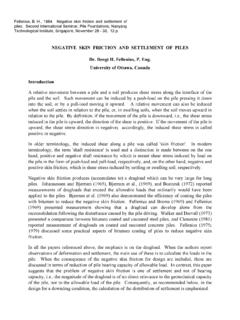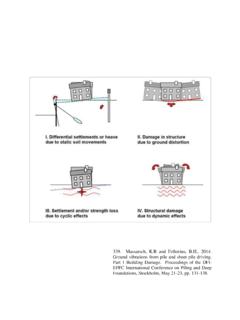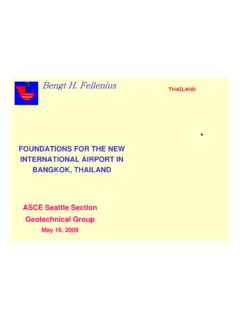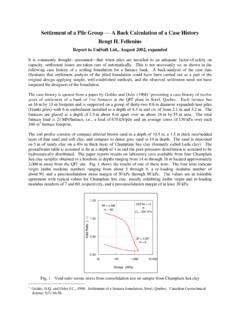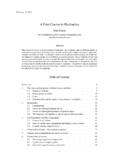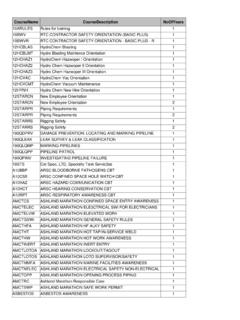Transcription of Bidirectional-cell tests on two 70 m long bored …
1 Bidirectional-cell tests on two 70 m long bored piles in Vietnam Nguyen and Fellenius, , 2014. Bidirectional-cell tests on two 70 m long bored piles in Vietnam. GeoInstitute Geo Congress, February 23 26, ASCE, Reston, VA, Magued Iskander, John E. Garlanger, and Mohamad H. Hussein, editors, Geotechnical Special Publication, GSP 233, pp. 482-496. Bidirectional-cell tests on Two 70 m Long bored Piles in Vietnam Nguyen Minh Hai1) and Bengt H. Fellenius2) , 1) Faculty of Civil Engng, Thu Dau Mot Univ., Binh Duong Province, Vietnam; 2) Consulting Engineer, 2475 Rothesay Avenue, Sidney, BC, Canada, V8L 2B9; ABSTRACT Static loading tests using single-level bidirectional - cells were carried out in mid-2008 on two bored piles constructed at the Binh Loi Bridge, crossing the Saigon River at Ho Chi Minh City, Vietnam.
2 The soils consist of surficial layers of soft clay and silt to 11 and 15 m depth on compact silty sand to about 55 m depth followed by dense to very dense silty sand. Two bored piles, m and m in diameter were installed to m and m depth, respectively, and constructed using reverse circulation technique and bucket drill with casing advanced ahead of the hole. Drilling slurry was composed of polymer slurry for the diameter pile and bentonite slurry for the diameter pile. For both piles, the cell assembly was attached to a reinforcing cage lowered into the stabilized hole to and m, respectively, above the pile toe, 5 and 2 days after completing drilling and cleaning, respectively. Each reinforcing cage was instrumented with two pairs of diametrically opposed vibrating wire strain-gages at three levels below and five levels above the cell level.
3 The static loading tests were performed 49 and 28 days, respectively, after the piles had been concreted. The strain-gage records, when based on the nominal pile diameters, indicated Young s modulus values of about 25 GPa for the nominal cross sections of the piles. Analysis of the records showed that residual load had developed during the wait time. The unit shaft resistance above the cell for the diameter, polymer-slurry constructed pile was moderately larger than that for the diameter, bentonite-slurry constructed pile. Detailed analysis showed the shaft resistance to be post-peak softening. The pile toe stress-movement responses were essentially linear and almost identical for the two piles. INTRODUCTION Static loading tests using single-level bidirectional - cells tests were carried out for two bored piles constructed using different drilling techniques at the Binh Loi Bridge, a cable-stayed bridge crossing the Saigon River at Ho Chi Minh City, Vietnam.
4 The Binh Loi Bridge is a part of Tan San Nhat Binh Loi Outer Ring Road Project connecting Tan Son Nhat International airport at Ho Chi Minh City to the city outer ring road. The Binh Loi Bridge will link up the Binh Thanh to Thu Duc district of Ho Chi Minh City across the Saigon River. It has a total length of 957 m with a 150 m long main span. The height above the river water level is 15 m. The bridge is supported on long bored piles constructed through deltaic alluvial soils, consisting of an about 40 m thick deposit of alternating layers of soft clay, compact silty sand, and soft to firm sandy clay, underlain by compact silty sand, becoming very dense at 70 m depth. The main span is supported on 2,000 mm diameter piles and the approach spans on 1,500 mm diameter piles.
5 The working loads were 10 MN and 6 MN, for the 2,000 mm and 1,500 mm diameter piles, respectively. As the assigned factor of safety was , the required pile capacities were 25 MN and 15 MN, respectively. FROM SOIL BEHAVIOR FUNDAMENTALS TO INNOVATIONS IN GEOTECHNICAL ENGINEERING 483 To verify that the design of the pile support is satisfactory, static loading tests were performed on one test pile of each diameter, constructed at opposite banks of the river, and 338 m apart, at a pier location nearest the river. The 2,000 mm diameter test pile, Pile D2000, was constructed on the east bank and the 1,500 mm diameter test pile, Pile D1500, on the west bank (Figure 1). The piles had almost the same embedment depth, m and m, respectively.
6 Both piles were strain-gage instrumented. The static loading test was performed by means of the bi-directional-cell test (Osterberg 1998). The results of the test are presented and correlated to the site conditions. The test data and back-analysis are considered to be of interest beyond the design of the foundations for the Binh Loi Bridge. SUBSURFACE CONDITIONS The Mekong River basin is composed of a Quaternary soil overlaying a Tertiary soil (Workman 1977). The upper part of the Mekong basin is filled in with recent deposits from the Mekong River and regional settlements occur in the general area. Pre-Holocene Cenozoic deposits frequently crop out, forming terraces along the Dong Nai and Saigon Rivers. The Saigon River has a total length of 256 km and cuts through an estuary delta stretching from Dau Tieng Lake to Dong Nai River confluence.
7 The seasonal variation of the river water surface elevation at the site is about 3 m. Fig. 1 Location of test piles and Boreholes The soil profile at the locations of the test piles (Piles D2000 and D1500) consists of surficial layers of soft clay and silt to 11 m and 15 m depths, respectively, underlain by compact silty sand to about 55 m depth followed by dense to very dense silty sand (Figure 2). At Pile D2000, a zone of clayey silt was encountered between 30 to 40 m depth in the borehole. Table 1 summarizes the soil parameters for the soil layers. The pore pressure distribution is hydrostatic and corresponds to a groundwater table at 3 m depth. Figure 3 shows the measured distribution of cone stress, sleeve friction, and U2 pore pressure from two CPTU soundings pushed close to the test pile locations.
8 The soundings were terminated once the cone encountered the compact silty sand. Figure 4 shows the distribution of SPT N-indices close to each test pile location Fig. 2 Location of test piles and Boreholes D2000 D15000 Binh Loi Bridge N FROM SOIL BEHAVIOR FUNDAMENTALS TO INNOVATIONS IN GEOTECHNICAL ENGINEERING 484 TEST PROGRAMME Details of the Test Piles and Instrumentation The two pre-production test piles, Pile D2000 and D1500, were drilled on May 20, 2008, and July 22, 2008, to m and m depth below grade, respectively. The diameter of Pile D2000 was 2,000 mm and the pile was supplied with a reinforcing cage of forty-four 32 mm bars, resulting in a steel reinforcement area of 350 cm2 and a reinforcement ratio of % of the m2 total nominal pile cross section.
9 The diameter of Pile D1500 was 1,500 mm and the pile was supplied with a reinforcing cage of thirty-two 32 mm bars, resulting in a steel reinforcement area of 260 cm2 and a reinforcement ratio of %, of the m2 total nominal pile cross section. The concrete cylinder strength was determined one week after casting to 35 MPa and 37 MPa for the concrete used in Piles D2000 and D1500, respectively. Fig. 2 Soil profile between the test piles TABLE 1 Soil Parameters Items Layer 1 Layer 2 Layer 3 Layer 4 Layer 5 Layer 6 Water content (wn) % 92 29 22 43 Saturated density ( sat) kg/m3 1,470 1,500 2,050 1,800 2,100 2,100 Void Ratio (e0) - - - Liquid Limit (LL) % 96 54 - Plastic Limit (PL) % 34 23 - Clay Fraction (%) (- -) 42 47 13 28 21 6 Silt Fraction (%) (- -) 55 46 20 45 12 12 Sand Fraction (%) (- -) 3 7 67 27 67 82 Friction Angle ( ) 0 3 13 20 13 31 23 Vane Shear Strength ( vb) kPa 14 28 11 SPT Index range 11-30 7-15 18->50 >50 134265 Pile D1500_ 0_25_50_75 D E P T H(m66 m68 m164 m40 mPile D20001.)
10 Soft clay and silt 2. Firm clay and silt 3. Compact silty sand some clay 4. Soft sandy clayey silt 5. Compact to very dense clayey sand, some silt6. Dense to very dense silty sand, some silt FROM SOIL BEHAVIOR FUNDAMENTALS TO INNOVATIONS IN GEOTECHNICAL ENGINEERING 485 The test piles were constructed by first inserting 2,032 mm and 1,520 mm outer diameter temporary casings, respectively, to 10 m depth. Thereafter, the D2000 and Pile D1500 shafts were drilled to m depth using reverse circulation drilling and to m depth using a bucket drill, respectively. The test piles were constructed by two separate contractors, each with a preference for the type of slurry to use; polymer slurry (Pile D2000) and bentonite slurry (Pile D1500).
